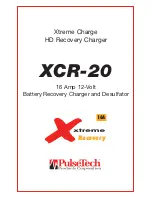
4
www.pulsetech.net
To reduce risk of battery explosion, follow these instructions and those published by battery
manufacturer and manufacturer of any equipment you intend to use in vicinity of battery.
Review cautionary marking on these products and on engine.
■
PERSONAL PRECAUTIONS:
Wear complete eye protection and clothing protection. Avoid touching eyes while working
near battery.
Someone should be within range of your voice or close enough to come to your aid when
you work near a lead-acid battery.
Have plenty of fresh water, soap and acid neutralizing agents (i.e. baking soda or ammonia)
nearby in case battery acid contacts skin, clothing, or eyes.
If battery acid contacts skin or clothing, wash immediately with soap and water. If acid
enters eye, immediately flood eye with running cold water for a least 10 minutes and get
medical attention immediately.
NEVER smoke or allow a spark or flame in vicinity of battery or engine.
Be extra cautious to reduce risk of dropping a metal tool on to battery. It might spark or
short-circuit battery or other electrical part that may cause an explosion.
Remove personal metal items such as rings, bracelets, necklaces, and watches when
working with a lead-acid battery. A lead-acid battery can produce a short-circuit current
high enough to weld a ring to metal, causing a severe burn.
Use charger for charging a LEAD-ACID battery only. It is not intended to supply power to a
low voltage electrical system other than in a starter-motor application. Do not use battery
charger for charging dry-cell batteries that are commonly used with home appliances.
These batteries may burst and a cause personal injury or property damage.
NEVER charge a frozen or obviously damaged battery.
■
PREPARING TO CHARGE:
Remove battery from vehicle to charge. Always remove grounded terminal from battery
first. Make sure all accessories in the vehicle are off, so as not to cause an arc.
Be sure area around battery is well ventilated while battery is being charged. Gas can be
forcefully blown away by using a piece of cardboard or other nonmetallic material, such as
a fan.
Clean battery terminals. Be careful to keep corrosion from coming contact with eyes.
Add distilled water in each cell until battery acid reaches level specified by battery
manufacturer. This helps purge excessive gas from cells. Do not overfill. For a battery
without cell caps, carefully follow manufacturer’s recharging instructions.
Study all battery manufacturers’ specific precautions such as removing or not removing cell
caps while charging and recommended rates of charge.








